Business Report: Small, Medium, Large Business Analysis of Tesco plc
VerifiedAdded on 2023/01/05
|13
|2834
|57
Report
AI Summary
This individual report provides a comprehensive analysis of Tesco plc, a multinational retail company. It begins by defining and differentiating between small, medium, and large businesses, followed by an examination of various business types including sole proprietorships, partnerships, limited liability businesses, public limited liability businesses, and cooperatives, with examples. The report then delves into organizational structures, identifying different types and explaining their impact on business productivity. Furthermore, it utilizes PESTLE analysis to assess how external factors, such as political, economic, and social influences, affect Tesco's performance. The report highlights key characteristics of each business type, providing real-world examples to illustrate the concepts and concludes with a discussion of Tesco's organizational structure and its adaptation to external challenges and opportunities.
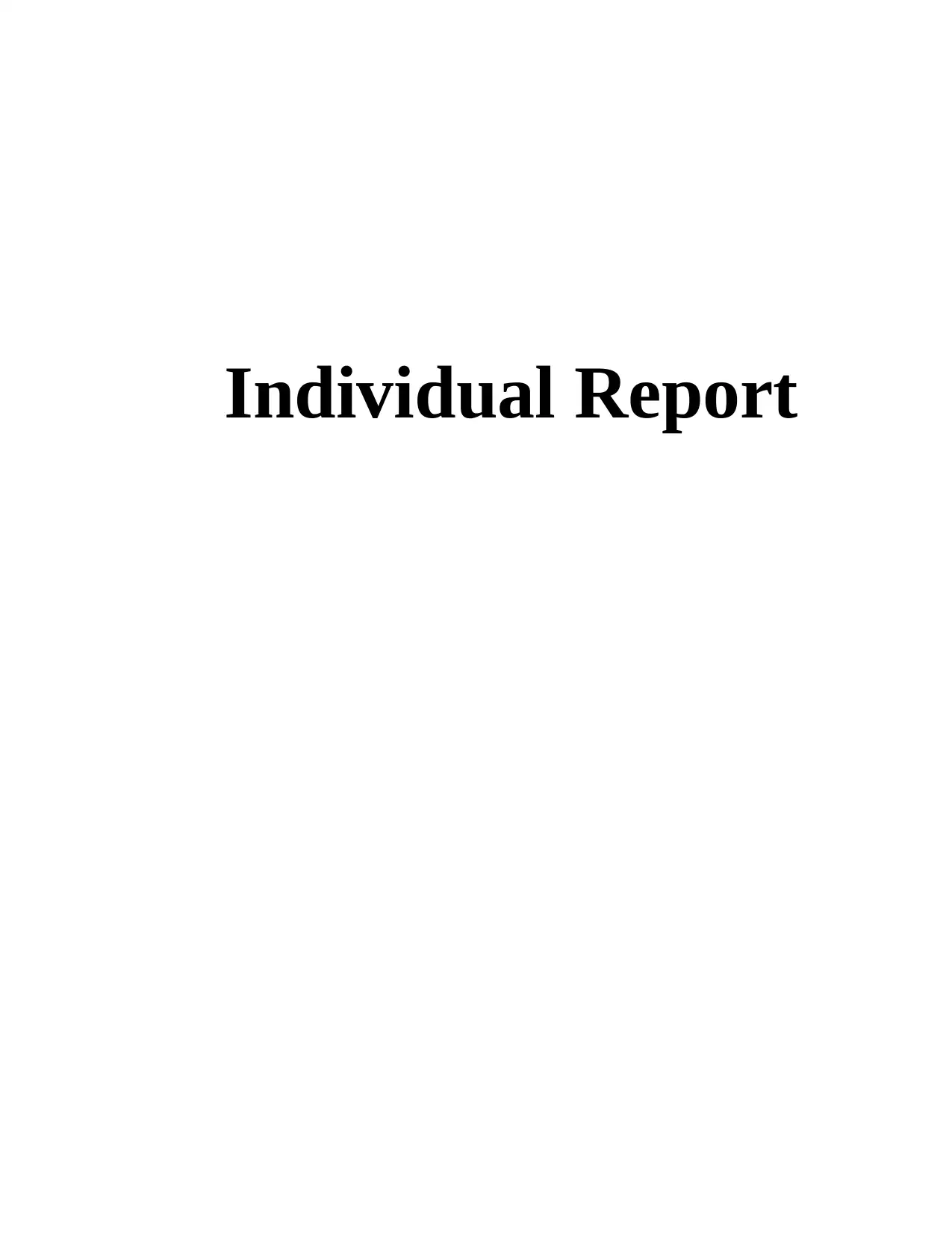
Individual Report
Paraphrase This Document
Need a fresh take? Get an instant paraphrase of this document with our AI Paraphraser
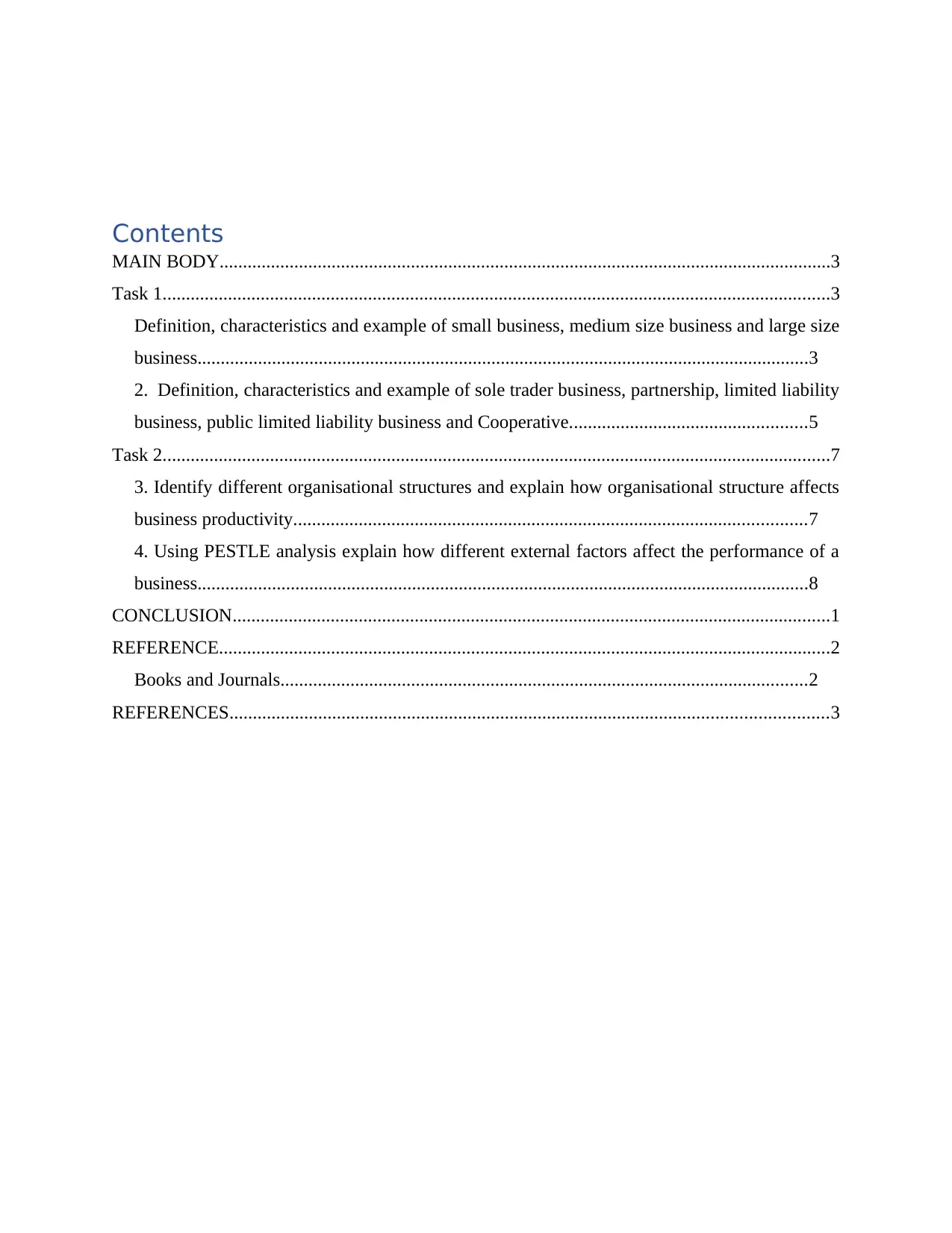
Contents
MAIN BODY...................................................................................................................................3
Task 1...............................................................................................................................................3
Definition, characteristics and example of small business, medium size business and large size
business...................................................................................................................................3
2. Definition, characteristics and example of sole trader business, partnership, limited liability
business, public limited liability business and Cooperative...................................................5
Task 2...............................................................................................................................................7
3. Identify different organisational structures and explain how organisational structure affects
business productivity..............................................................................................................7
4. Using PESTLE analysis explain how different external factors affect the performance of a
business...................................................................................................................................8
CONCLUSION................................................................................................................................1
REFERENCE...................................................................................................................................2
Books and Journals.................................................................................................................2
REFERENCES................................................................................................................................3
MAIN BODY...................................................................................................................................3
Task 1...............................................................................................................................................3
Definition, characteristics and example of small business, medium size business and large size
business...................................................................................................................................3
2. Definition, characteristics and example of sole trader business, partnership, limited liability
business, public limited liability business and Cooperative...................................................5
Task 2...............................................................................................................................................7
3. Identify different organisational structures and explain how organisational structure affects
business productivity..............................................................................................................7
4. Using PESTLE analysis explain how different external factors affect the performance of a
business...................................................................................................................................8
CONCLUSION................................................................................................................................1
REFERENCE...................................................................................................................................2
Books and Journals.................................................................................................................2
REFERENCES................................................................................................................................3
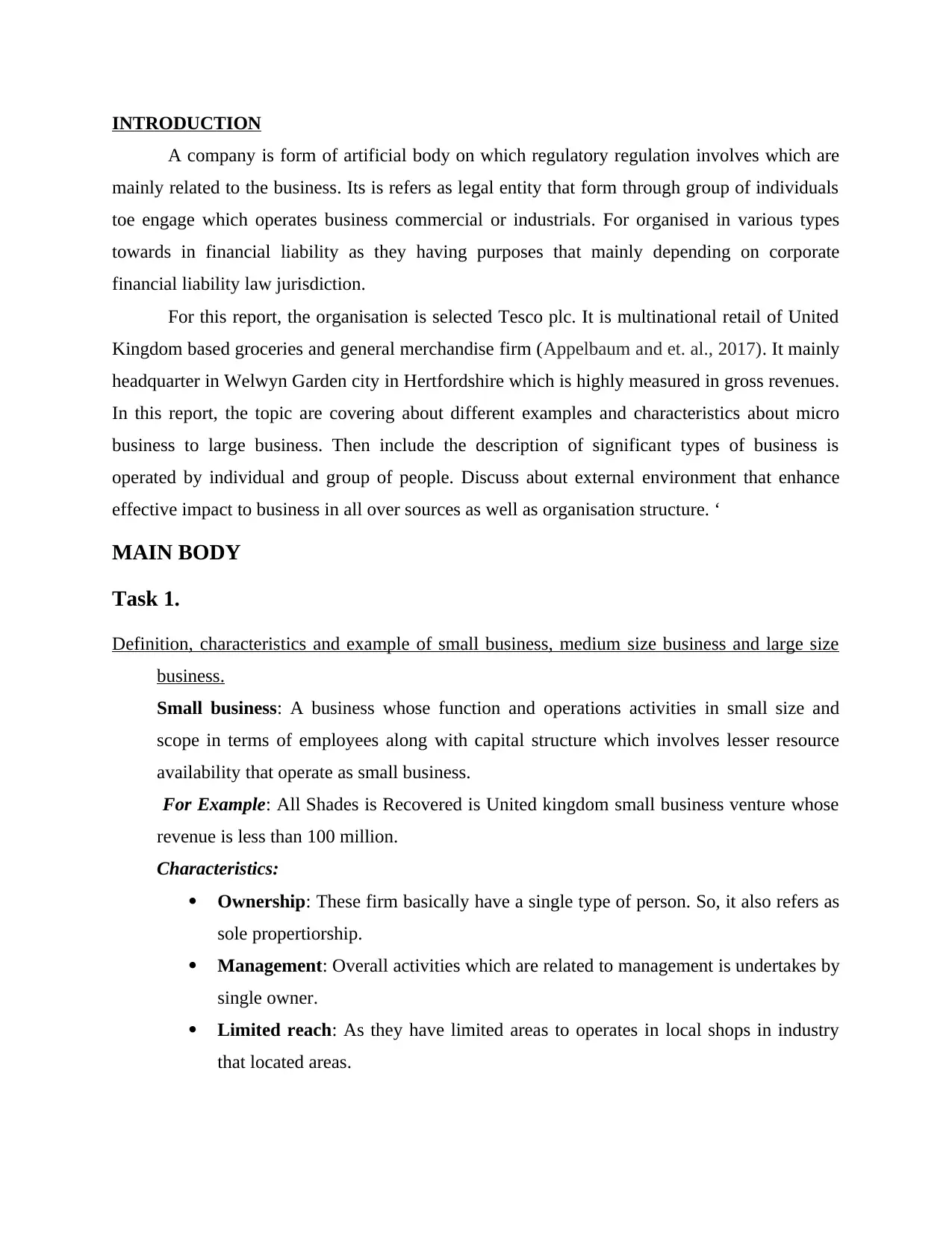
INTRODUCTION
A company is form of artificial body on which regulatory regulation involves which are
mainly related to the business. Its is refers as legal entity that form through group of individuals
toe engage which operates business commercial or industrials. For organised in various types
towards in financial liability as they having purposes that mainly depending on corporate
financial liability law jurisdiction.
For this report, the organisation is selected Tesco plc. It is multinational retail of United
Kingdom based groceries and general merchandise firm (Appelbaum and et. al., 2017). It mainly
headquarter in Welwyn Garden city in Hertfordshire which is highly measured in gross revenues.
In this report, the topic are covering about different examples and characteristics about micro
business to large business. Then include the description of significant types of business is
operated by individual and group of people. Discuss about external environment that enhance
effective impact to business in all over sources as well as organisation structure. ‘
MAIN BODY
Task 1.
Definition, characteristics and example of small business, medium size business and large size
business.
Small business: A business whose function and operations activities in small size and
scope in terms of employees along with capital structure which involves lesser resource
availability that operate as small business.
For Example: All Shades is Recovered is United kingdom small business venture whose
revenue is less than 100 million.
Characteristics:
Ownership: These firm basically have a single type of person. So, it also refers as
sole propertiorship.
Management: Overall activities which are related to management is undertakes by
single owner.
Limited reach: As they have limited areas to operates in local shops in industry
that located areas.
A company is form of artificial body on which regulatory regulation involves which are
mainly related to the business. Its is refers as legal entity that form through group of individuals
toe engage which operates business commercial or industrials. For organised in various types
towards in financial liability as they having purposes that mainly depending on corporate
financial liability law jurisdiction.
For this report, the organisation is selected Tesco plc. It is multinational retail of United
Kingdom based groceries and general merchandise firm (Appelbaum and et. al., 2017). It mainly
headquarter in Welwyn Garden city in Hertfordshire which is highly measured in gross revenues.
In this report, the topic are covering about different examples and characteristics about micro
business to large business. Then include the description of significant types of business is
operated by individual and group of people. Discuss about external environment that enhance
effective impact to business in all over sources as well as organisation structure. ‘
MAIN BODY
Task 1.
Definition, characteristics and example of small business, medium size business and large size
business.
Small business: A business whose function and operations activities in small size and
scope in terms of employees along with capital structure which involves lesser resource
availability that operate as small business.
For Example: All Shades is Recovered is United kingdom small business venture whose
revenue is less than 100 million.
Characteristics:
Ownership: These firm basically have a single type of person. So, it also refers as
sole propertiorship.
Management: Overall activities which are related to management is undertakes by
single owner.
Limited reach: As they have limited areas to operates in local shops in industry
that located areas.
⊘ This is a preview!⊘
Do you want full access?
Subscribe today to unlock all pages.

Trusted by 1+ million students worldwide
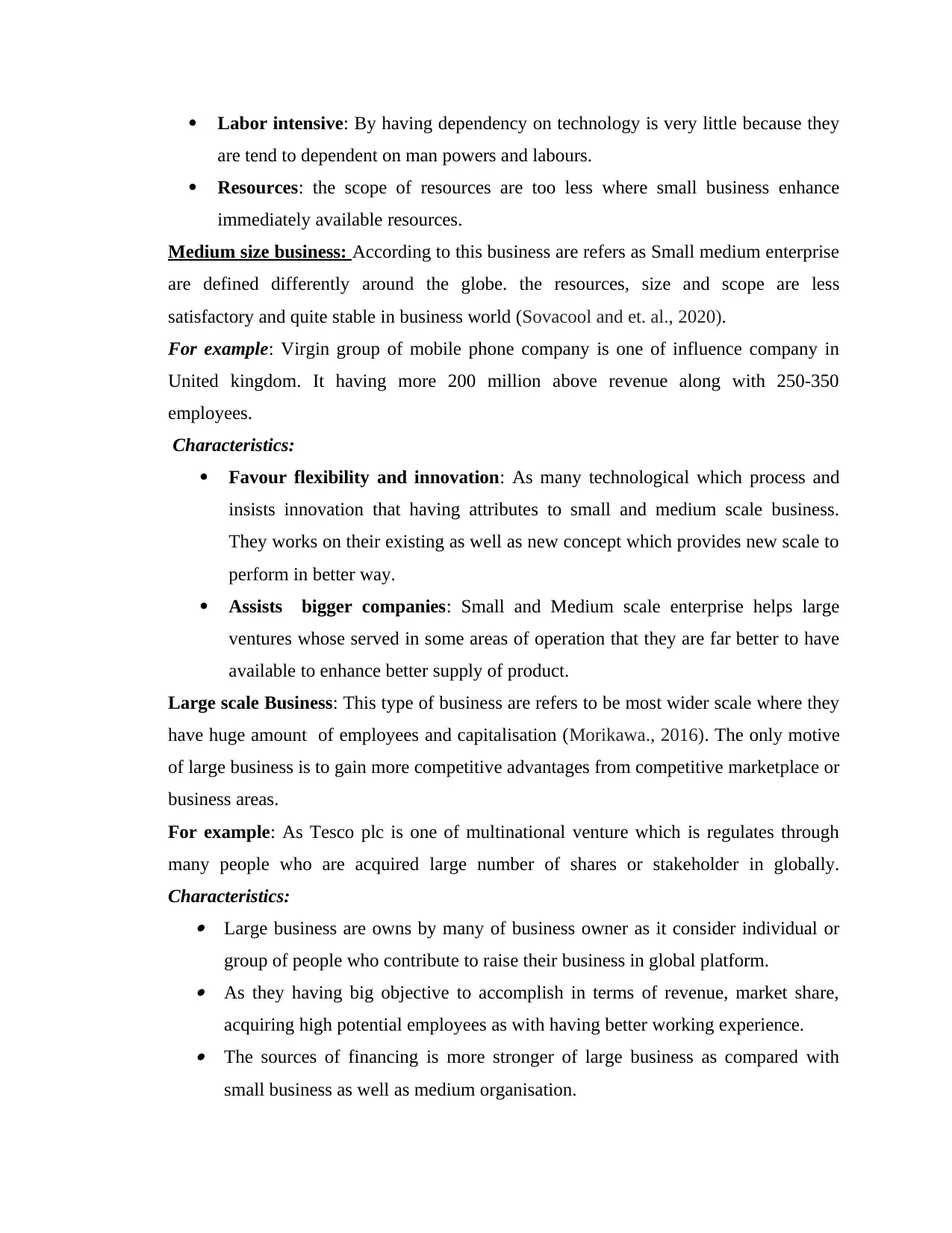
Labor intensive: By having dependency on technology is very little because they
are tend to dependent on man powers and labours.
Resources: the scope of resources are too less where small business enhance
immediately available resources.
Medium size business: According to this business are refers as Small medium enterprise
are defined differently around the globe. the resources, size and scope are less
satisfactory and quite stable in business world (Sovacool and et. al., 2020).
For example: Virgin group of mobile phone company is one of influence company in
United kingdom. It having more 200 million above revenue along with 250-350
employees.
Characteristics:
Favour flexibility and innovation: As many technological which process and
insists innovation that having attributes to small and medium scale business.
They works on their existing as well as new concept which provides new scale to
perform in better way.
Assists bigger companies: Small and Medium scale enterprise helps large
ventures whose served in some areas of operation that they are far better to have
available to enhance better supply of product.
Large scale Business: This type of business are refers to be most wider scale where they
have huge amount of employees and capitalisation (Morikawa., 2016). The only motive
of large business is to gain more competitive advantages from competitive marketplace or
business areas.
For example: As Tesco plc is one of multinational venture which is regulates through
many people who are acquired large number of shares or stakeholder in globally.
Characteristics:
Large business are owns by many of business owner as it consider individual or
group of people who contribute to raise their business in global platform.
As they having big objective to accomplish in terms of revenue, market share,
acquiring high potential employees as with having better working experience.
The sources of financing is more stronger of large business as compared with
small business as well as medium organisation.
are tend to dependent on man powers and labours.
Resources: the scope of resources are too less where small business enhance
immediately available resources.
Medium size business: According to this business are refers as Small medium enterprise
are defined differently around the globe. the resources, size and scope are less
satisfactory and quite stable in business world (Sovacool and et. al., 2020).
For example: Virgin group of mobile phone company is one of influence company in
United kingdom. It having more 200 million above revenue along with 250-350
employees.
Characteristics:
Favour flexibility and innovation: As many technological which process and
insists innovation that having attributes to small and medium scale business.
They works on their existing as well as new concept which provides new scale to
perform in better way.
Assists bigger companies: Small and Medium scale enterprise helps large
ventures whose served in some areas of operation that they are far better to have
available to enhance better supply of product.
Large scale Business: This type of business are refers to be most wider scale where they
have huge amount of employees and capitalisation (Morikawa., 2016). The only motive
of large business is to gain more competitive advantages from competitive marketplace or
business areas.
For example: As Tesco plc is one of multinational venture which is regulates through
many people who are acquired large number of shares or stakeholder in globally.
Characteristics:
Large business are owns by many of business owner as it consider individual or
group of people who contribute to raise their business in global platform.
As they having big objective to accomplish in terms of revenue, market share,
acquiring high potential employees as with having better working experience.
The sources of financing is more stronger of large business as compared with
small business as well as medium organisation.
Paraphrase This Document
Need a fresh take? Get an instant paraphrase of this document with our AI Paraphraser
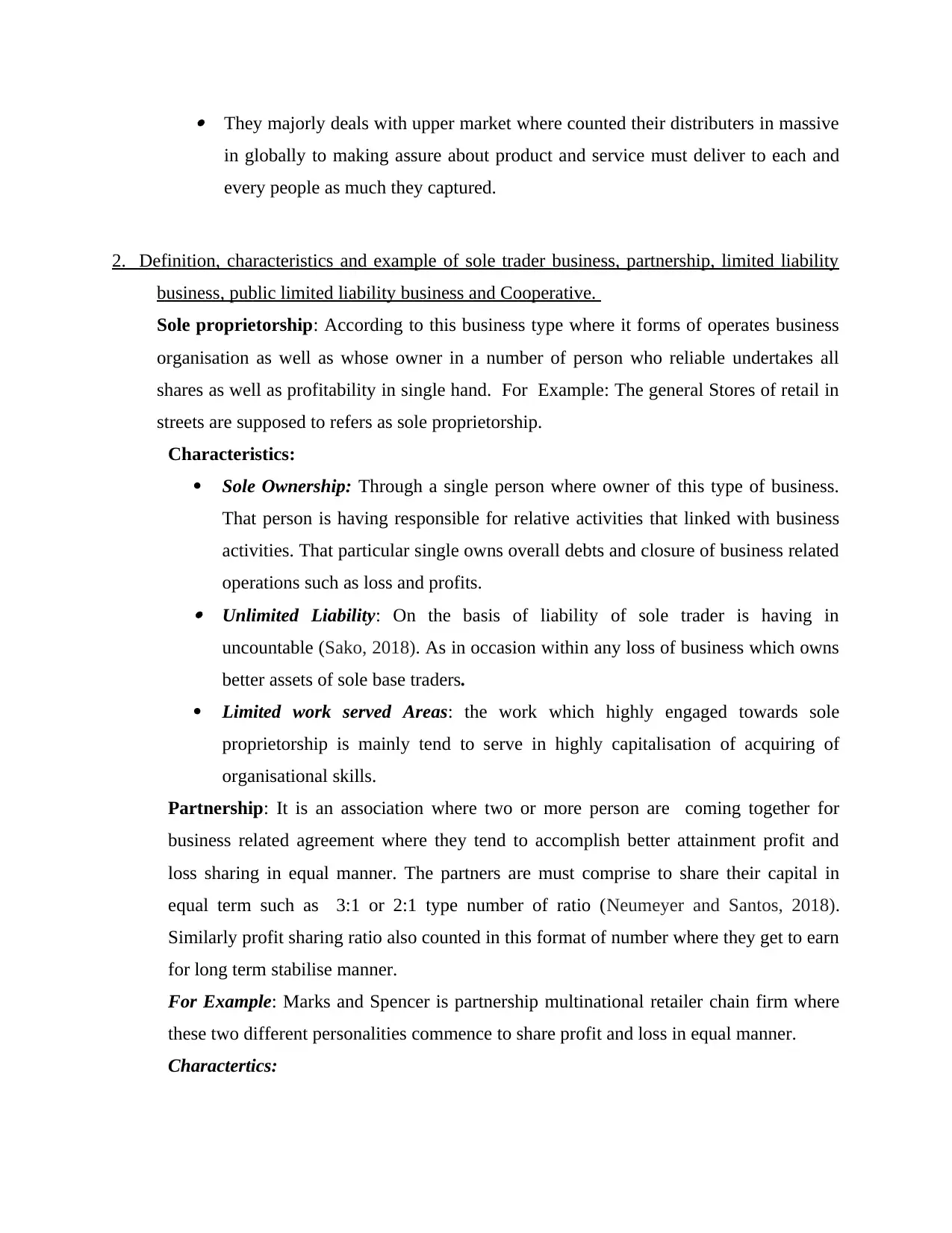
They majorly deals with upper market where counted their distributers in massive
in globally to making assure about product and service must deliver to each and
every people as much they captured.
2. Definition, characteristics and example of sole trader business, partnership, limited liability
business, public limited liability business and Cooperative.
Sole proprietorship: According to this business type where it forms of operates business
organisation as well as whose owner in a number of person who reliable undertakes all
shares as well as profitability in single hand. For Example: The general Stores of retail in
streets are supposed to refers as sole proprietorship.
Characteristics:
Sole Ownership: Through a single person where owner of this type of business.
That person is having responsible for relative activities that linked with business
activities. That particular single owns overall debts and closure of business related
operations such as loss and profits.
Unlimited Liability: On the basis of liability of sole trader is having in
uncountable (Sako, 2018). As in occasion within any loss of business which owns
better assets of sole base traders.
Limited work served Areas: the work which highly engaged towards sole
proprietorship is mainly tend to serve in highly capitalisation of acquiring of
organisational skills.
Partnership: It is an association where two or more person are coming together for
business related agreement where they tend to accomplish better attainment profit and
loss sharing in equal manner. The partners are must comprise to share their capital in
equal term such as 3:1 or 2:1 type number of ratio (Neumeyer and Santos, 2018).
Similarly profit sharing ratio also counted in this format of number where they get to earn
for long term stabilise manner.
For Example: Marks and Spencer is partnership multinational retailer chain firm where
these two different personalities commence to share profit and loss in equal manner.
Charactertics:
in globally to making assure about product and service must deliver to each and
every people as much they captured.
2. Definition, characteristics and example of sole trader business, partnership, limited liability
business, public limited liability business and Cooperative.
Sole proprietorship: According to this business type where it forms of operates business
organisation as well as whose owner in a number of person who reliable undertakes all
shares as well as profitability in single hand. For Example: The general Stores of retail in
streets are supposed to refers as sole proprietorship.
Characteristics:
Sole Ownership: Through a single person where owner of this type of business.
That person is having responsible for relative activities that linked with business
activities. That particular single owns overall debts and closure of business related
operations such as loss and profits.
Unlimited Liability: On the basis of liability of sole trader is having in
uncountable (Sako, 2018). As in occasion within any loss of business which owns
better assets of sole base traders.
Limited work served Areas: the work which highly engaged towards sole
proprietorship is mainly tend to serve in highly capitalisation of acquiring of
organisational skills.
Partnership: It is an association where two or more person are coming together for
business related agreement where they tend to accomplish better attainment profit and
loss sharing in equal manner. The partners are must comprise to share their capital in
equal term such as 3:1 or 2:1 type number of ratio (Neumeyer and Santos, 2018).
Similarly profit sharing ratio also counted in this format of number where they get to earn
for long term stabilise manner.
For Example: Marks and Spencer is partnership multinational retailer chain firm where
these two different personalities commence to share profit and loss in equal manner.
Charactertics:
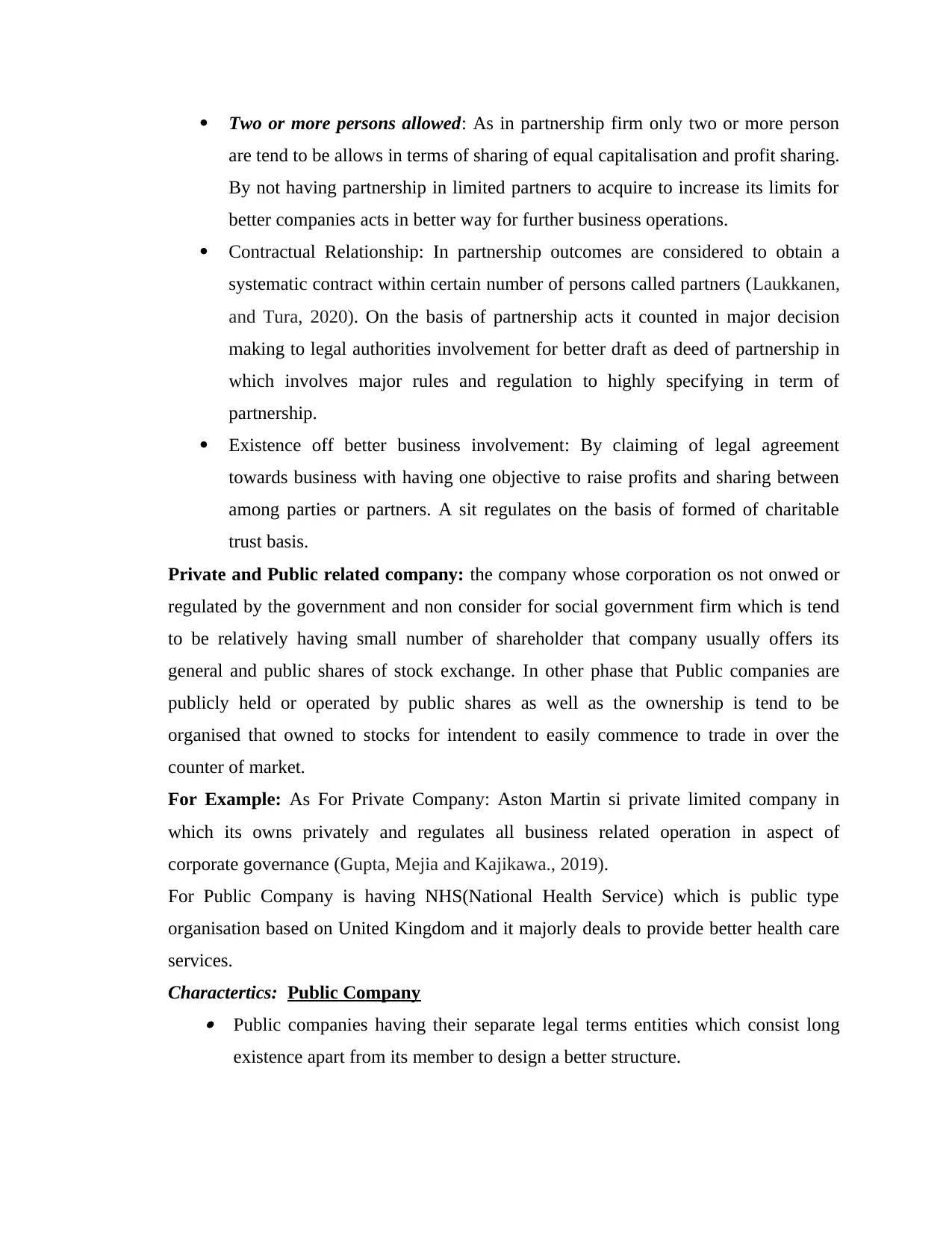
Two or more persons allowed: As in partnership firm only two or more person
are tend to be allows in terms of sharing of equal capitalisation and profit sharing.
By not having partnership in limited partners to acquire to increase its limits for
better companies acts in better way for further business operations.
Contractual Relationship: In partnership outcomes are considered to obtain a
systematic contract within certain number of persons called partners (Laukkanen,
and Tura, 2020). On the basis of partnership acts it counted in major decision
making to legal authorities involvement for better draft as deed of partnership in
which involves major rules and regulation to highly specifying in term of
partnership.
Existence off better business involvement: By claiming of legal agreement
towards business with having one objective to raise profits and sharing between
among parties or partners. A sit regulates on the basis of formed of charitable
trust basis.
Private and Public related company: the company whose corporation os not onwed or
regulated by the government and non consider for social government firm which is tend
to be relatively having small number of shareholder that company usually offers its
general and public shares of stock exchange. In other phase that Public companies are
publicly held or operated by public shares as well as the ownership is tend to be
organised that owned to stocks for intendent to easily commence to trade in over the
counter of market.
For Example: As For Private Company: Aston Martin si private limited company in
which its owns privately and regulates all business related operation in aspect of
corporate governance (Gupta, Mejia and Kajikawa., 2019).
For Public Company is having NHS(National Health Service) which is public type
organisation based on United Kingdom and it majorly deals to provide better health care
services.
Charactertics: Public Company
Public companies having their separate legal terms entities which consist long
existence apart from its member to design a better structure.
are tend to be allows in terms of sharing of equal capitalisation and profit sharing.
By not having partnership in limited partners to acquire to increase its limits for
better companies acts in better way for further business operations.
Contractual Relationship: In partnership outcomes are considered to obtain a
systematic contract within certain number of persons called partners (Laukkanen,
and Tura, 2020). On the basis of partnership acts it counted in major decision
making to legal authorities involvement for better draft as deed of partnership in
which involves major rules and regulation to highly specifying in term of
partnership.
Existence off better business involvement: By claiming of legal agreement
towards business with having one objective to raise profits and sharing between
among parties or partners. A sit regulates on the basis of formed of charitable
trust basis.
Private and Public related company: the company whose corporation os not onwed or
regulated by the government and non consider for social government firm which is tend
to be relatively having small number of shareholder that company usually offers its
general and public shares of stock exchange. In other phase that Public companies are
publicly held or operated by public shares as well as the ownership is tend to be
organised that owned to stocks for intendent to easily commence to trade in over the
counter of market.
For Example: As For Private Company: Aston Martin si private limited company in
which its owns privately and regulates all business related operation in aspect of
corporate governance (Gupta, Mejia and Kajikawa., 2019).
For Public Company is having NHS(National Health Service) which is public type
organisation based on United Kingdom and it majorly deals to provide better health care
services.
Charactertics: Public Company
Public companies having their separate legal terms entities which consist long
existence apart from its member to design a better structure.
⊘ This is a preview!⊘
Do you want full access?
Subscribe today to unlock all pages.

Trusted by 1+ million students worldwide
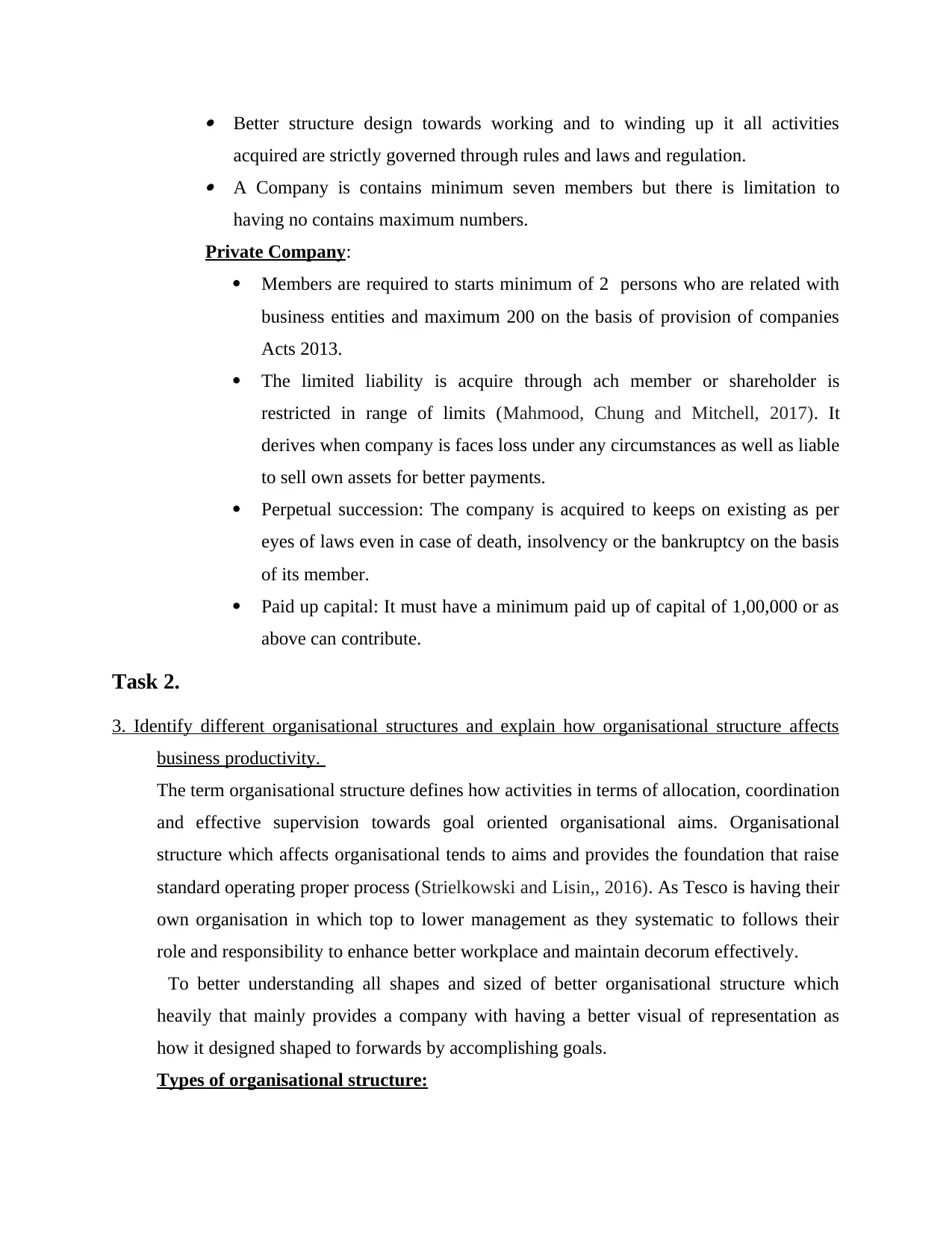
Better structure design towards working and to winding up it all activities
acquired are strictly governed through rules and laws and regulation.
A Company is contains minimum seven members but there is limitation to
having no contains maximum numbers.
Private Company:
Members are required to starts minimum of 2 persons who are related with
business entities and maximum 200 on the basis of provision of companies
Acts 2013.
The limited liability is acquire through ach member or shareholder is
restricted in range of limits (Mahmood, Chung and Mitchell, 2017). It
derives when company is faces loss under any circumstances as well as liable
to sell own assets for better payments.
Perpetual succession: The company is acquired to keeps on existing as per
eyes of laws even in case of death, insolvency or the bankruptcy on the basis
of its member.
Paid up capital: It must have a minimum paid up of capital of 1,00,000 or as
above can contribute.
Task 2.
3. Identify different organisational structures and explain how organisational structure affects
business productivity.
The term organisational structure defines how activities in terms of allocation, coordination
and effective supervision towards goal oriented organisational aims. Organisational
structure which affects organisational tends to aims and provides the foundation that raise
standard operating proper process (Strielkowski and Lisin,, 2016). As Tesco is having their
own organisation in which top to lower management as they systematic to follows their
role and responsibility to enhance better workplace and maintain decorum effectively.
To better understanding all shapes and sized of better organisational structure which
heavily that mainly provides a company with having a better visual of representation as
how it designed shaped to forwards by accomplishing goals.
Types of organisational structure:
acquired are strictly governed through rules and laws and regulation.
A Company is contains minimum seven members but there is limitation to
having no contains maximum numbers.
Private Company:
Members are required to starts minimum of 2 persons who are related with
business entities and maximum 200 on the basis of provision of companies
Acts 2013.
The limited liability is acquire through ach member or shareholder is
restricted in range of limits (Mahmood, Chung and Mitchell, 2017). It
derives when company is faces loss under any circumstances as well as liable
to sell own assets for better payments.
Perpetual succession: The company is acquired to keeps on existing as per
eyes of laws even in case of death, insolvency or the bankruptcy on the basis
of its member.
Paid up capital: It must have a minimum paid up of capital of 1,00,000 or as
above can contribute.
Task 2.
3. Identify different organisational structures and explain how organisational structure affects
business productivity.
The term organisational structure defines how activities in terms of allocation, coordination
and effective supervision towards goal oriented organisational aims. Organisational
structure which affects organisational tends to aims and provides the foundation that raise
standard operating proper process (Strielkowski and Lisin,, 2016). As Tesco is having their
own organisation in which top to lower management as they systematic to follows their
role and responsibility to enhance better workplace and maintain decorum effectively.
To better understanding all shapes and sized of better organisational structure which
heavily that mainly provides a company with having a better visual of representation as
how it designed shaped to forwards by accomplishing goals.
Types of organisational structure:
Paraphrase This Document
Need a fresh take? Get an instant paraphrase of this document with our AI Paraphraser
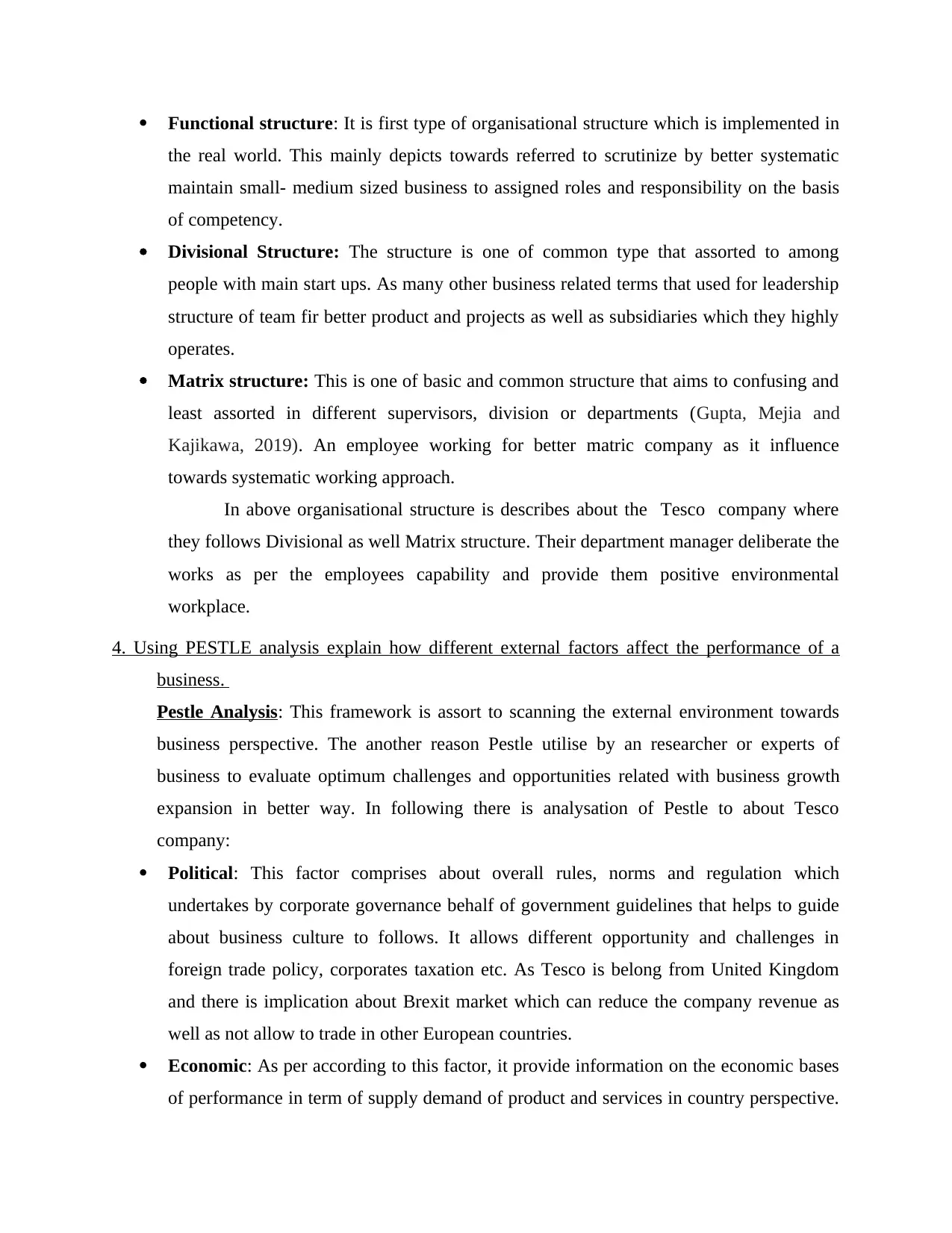
Functional structure: It is first type of organisational structure which is implemented in
the real world. This mainly depicts towards referred to scrutinize by better systematic
maintain small- medium sized business to assigned roles and responsibility on the basis
of competency.
Divisional Structure: The structure is one of common type that assorted to among
people with main start ups. As many other business related terms that used for leadership
structure of team fir better product and projects as well as subsidiaries which they highly
operates.
Matrix structure: This is one of basic and common structure that aims to confusing and
least assorted in different supervisors, division or departments (Gupta, Mejia and
Kajikawa, 2019). An employee working for better matric company as it influence
towards systematic working approach.
In above organisational structure is describes about the Tesco company where
they follows Divisional as well Matrix structure. Their department manager deliberate the
works as per the employees capability and provide them positive environmental
workplace.
4. Using PESTLE analysis explain how different external factors affect the performance of a
business.
Pestle Analysis: This framework is assort to scanning the external environment towards
business perspective. The another reason Pestle utilise by an researcher or experts of
business to evaluate optimum challenges and opportunities related with business growth
expansion in better way. In following there is analysation of Pestle to about Tesco
company:
Political: This factor comprises about overall rules, norms and regulation which
undertakes by corporate governance behalf of government guidelines that helps to guide
about business culture to follows. It allows different opportunity and challenges in
foreign trade policy, corporates taxation etc. As Tesco is belong from United Kingdom
and there is implication about Brexit market which can reduce the company revenue as
well as not allow to trade in other European countries.
Economic: As per according to this factor, it provide information on the economic bases
of performance in term of supply demand of product and services in country perspective.
the real world. This mainly depicts towards referred to scrutinize by better systematic
maintain small- medium sized business to assigned roles and responsibility on the basis
of competency.
Divisional Structure: The structure is one of common type that assorted to among
people with main start ups. As many other business related terms that used for leadership
structure of team fir better product and projects as well as subsidiaries which they highly
operates.
Matrix structure: This is one of basic and common structure that aims to confusing and
least assorted in different supervisors, division or departments (Gupta, Mejia and
Kajikawa, 2019). An employee working for better matric company as it influence
towards systematic working approach.
In above organisational structure is describes about the Tesco company where
they follows Divisional as well Matrix structure. Their department manager deliberate the
works as per the employees capability and provide them positive environmental
workplace.
4. Using PESTLE analysis explain how different external factors affect the performance of a
business.
Pestle Analysis: This framework is assort to scanning the external environment towards
business perspective. The another reason Pestle utilise by an researcher or experts of
business to evaluate optimum challenges and opportunities related with business growth
expansion in better way. In following there is analysation of Pestle to about Tesco
company:
Political: This factor comprises about overall rules, norms and regulation which
undertakes by corporate governance behalf of government guidelines that helps to guide
about business culture to follows. It allows different opportunity and challenges in
foreign trade policy, corporates taxation etc. As Tesco is belong from United Kingdom
and there is implication about Brexit market which can reduce the company revenue as
well as not allow to trade in other European countries.
Economic: As per according to this factor, it provide information on the economic bases
of performance in term of supply demand of product and services in country perspective.
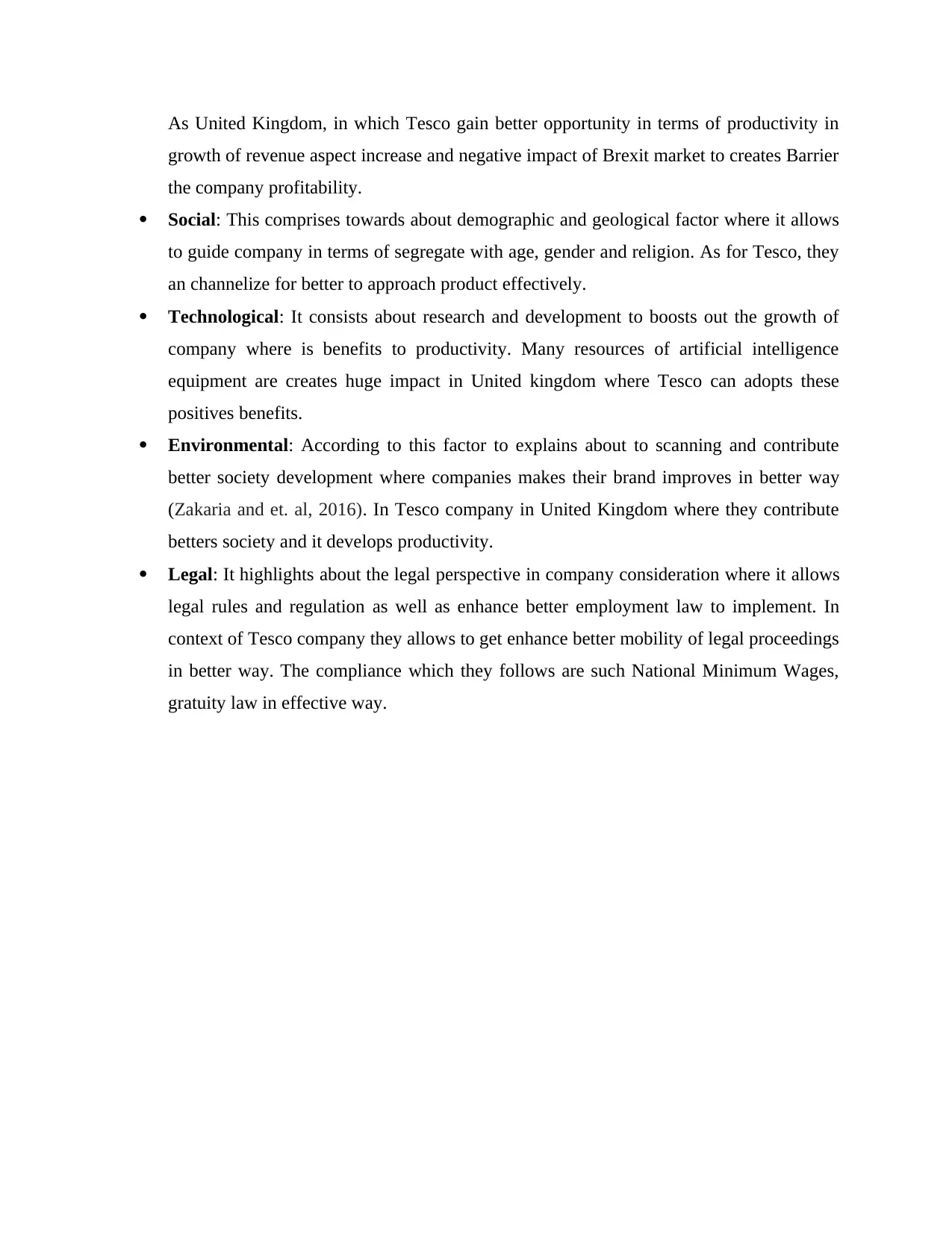
As United Kingdom, in which Tesco gain better opportunity in terms of productivity in
growth of revenue aspect increase and negative impact of Brexit market to creates Barrier
the company profitability.
Social: This comprises towards about demographic and geological factor where it allows
to guide company in terms of segregate with age, gender and religion. As for Tesco, they
an channelize for better to approach product effectively.
Technological: It consists about research and development to boosts out the growth of
company where is benefits to productivity. Many resources of artificial intelligence
equipment are creates huge impact in United kingdom where Tesco can adopts these
positives benefits.
Environmental: According to this factor to explains about to scanning and contribute
better society development where companies makes their brand improves in better way
(Zakaria and et. al, 2016). In Tesco company in United Kingdom where they contribute
betters society and it develops productivity.
Legal: It highlights about the legal perspective in company consideration where it allows
legal rules and regulation as well as enhance better employment law to implement. In
context of Tesco company they allows to get enhance better mobility of legal proceedings
in better way. The compliance which they follows are such National Minimum Wages,
gratuity law in effective way.
growth of revenue aspect increase and negative impact of Brexit market to creates Barrier
the company profitability.
Social: This comprises towards about demographic and geological factor where it allows
to guide company in terms of segregate with age, gender and religion. As for Tesco, they
an channelize for better to approach product effectively.
Technological: It consists about research and development to boosts out the growth of
company where is benefits to productivity. Many resources of artificial intelligence
equipment are creates huge impact in United kingdom where Tesco can adopts these
positives benefits.
Environmental: According to this factor to explains about to scanning and contribute
better society development where companies makes their brand improves in better way
(Zakaria and et. al, 2016). In Tesco company in United Kingdom where they contribute
betters society and it develops productivity.
Legal: It highlights about the legal perspective in company consideration where it allows
legal rules and regulation as well as enhance better employment law to implement. In
context of Tesco company they allows to get enhance better mobility of legal proceedings
in better way. The compliance which they follows are such National Minimum Wages,
gratuity law in effective way.
⊘ This is a preview!⊘
Do you want full access?
Subscribe today to unlock all pages.

Trusted by 1+ million students worldwide
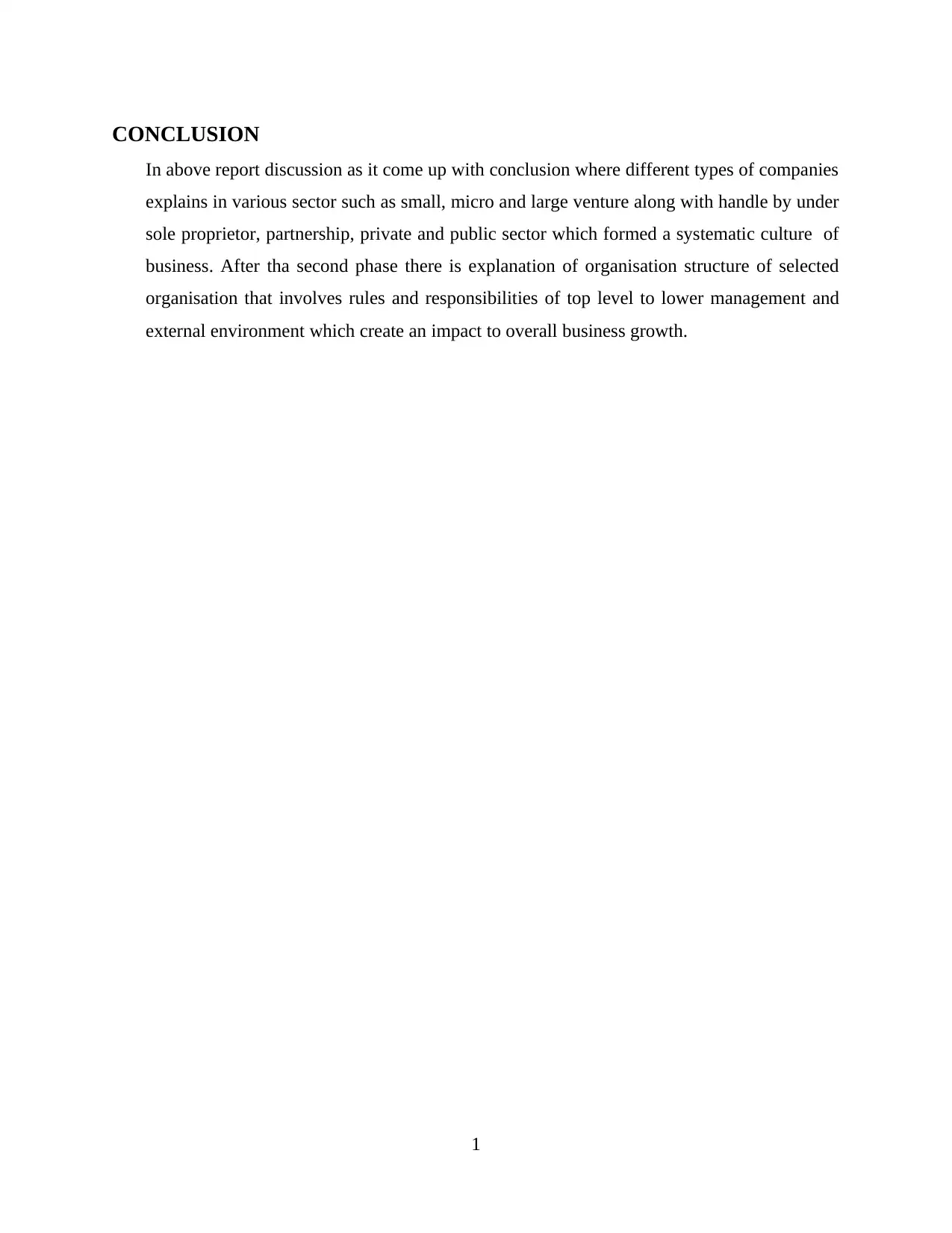
CONCLUSION
In above report discussion as it come up with conclusion where different types of companies
explains in various sector such as small, micro and large venture along with handle by under
sole proprietor, partnership, private and public sector which formed a systematic culture of
business. After tha second phase there is explanation of organisation structure of selected
organisation that involves rules and responsibilities of top level to lower management and
external environment which create an impact to overall business growth.
1
In above report discussion as it come up with conclusion where different types of companies
explains in various sector such as small, micro and large venture along with handle by under
sole proprietor, partnership, private and public sector which formed a systematic culture of
business. After tha second phase there is explanation of organisation structure of selected
organisation that involves rules and responsibilities of top level to lower management and
external environment which create an impact to overall business growth.
1
Paraphrase This Document
Need a fresh take? Get an instant paraphrase of this document with our AI Paraphraser
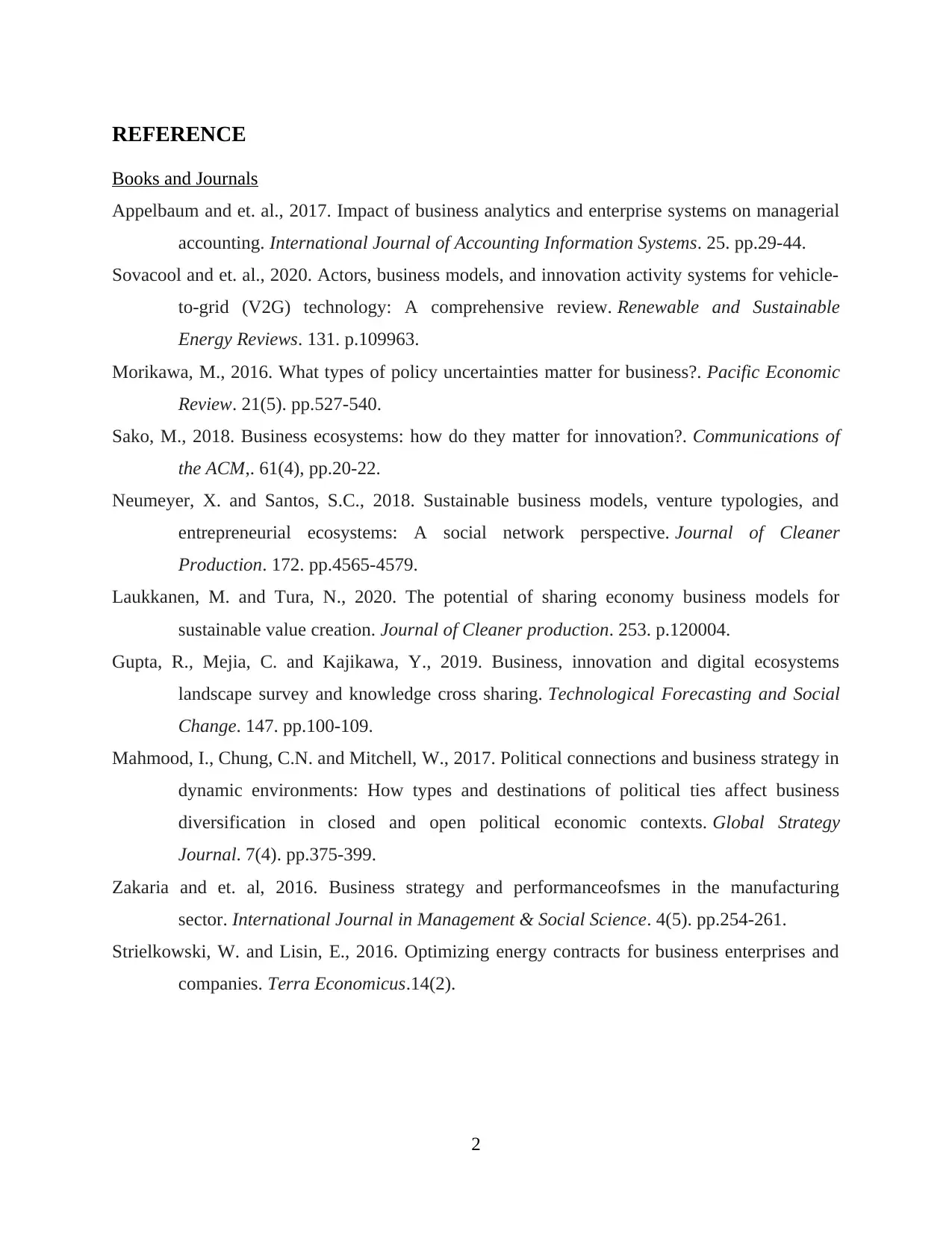
REFERENCE
Books and Journals
Appelbaum and et. al., 2017. Impact of business analytics and enterprise systems on managerial
accounting. International Journal of Accounting Information Systems. 25. pp.29-44.
Sovacool and et. al., 2020. Actors, business models, and innovation activity systems for vehicle-
to-grid (V2G) technology: A comprehensive review. Renewable and Sustainable
Energy Reviews. 131. p.109963.
Morikawa, M., 2016. What types of policy uncertainties matter for business?. Pacific Economic
Review. 21(5). pp.527-540.
Sako, M., 2018. Business ecosystems: how do they matter for innovation?. Communications of
the ACM,. 61(4), pp.20-22.
Neumeyer, X. and Santos, S.C., 2018. Sustainable business models, venture typologies, and
entrepreneurial ecosystems: A social network perspective. Journal of Cleaner
Production. 172. pp.4565-4579.
Laukkanen, M. and Tura, N., 2020. The potential of sharing economy business models for
sustainable value creation. Journal of Cleaner production. 253. p.120004.
Gupta, R., Mejia, C. and Kajikawa, Y., 2019. Business, innovation and digital ecosystems
landscape survey and knowledge cross sharing. Technological Forecasting and Social
Change. 147. pp.100-109.
Mahmood, I., Chung, C.N. and Mitchell, W., 2017. Political connections and business strategy in
dynamic environments: How types and destinations of political ties affect business
diversification in closed and open political economic contexts. Global Strategy
Journal. 7(4). pp.375-399.
Zakaria and et. al, 2016. Business strategy and performanceofsmes in the manufacturing
sector. International Journal in Management & Social Science. 4(5). pp.254-261.
Strielkowski, W. and Lisin, E., 2016. Optimizing energy contracts for business enterprises and
companies. Terra Economicus.14(2).
2
Books and Journals
Appelbaum and et. al., 2017. Impact of business analytics and enterprise systems on managerial
accounting. International Journal of Accounting Information Systems. 25. pp.29-44.
Sovacool and et. al., 2020. Actors, business models, and innovation activity systems for vehicle-
to-grid (V2G) technology: A comprehensive review. Renewable and Sustainable
Energy Reviews. 131. p.109963.
Morikawa, M., 2016. What types of policy uncertainties matter for business?. Pacific Economic
Review. 21(5). pp.527-540.
Sako, M., 2018. Business ecosystems: how do they matter for innovation?. Communications of
the ACM,. 61(4), pp.20-22.
Neumeyer, X. and Santos, S.C., 2018. Sustainable business models, venture typologies, and
entrepreneurial ecosystems: A social network perspective. Journal of Cleaner
Production. 172. pp.4565-4579.
Laukkanen, M. and Tura, N., 2020. The potential of sharing economy business models for
sustainable value creation. Journal of Cleaner production. 253. p.120004.
Gupta, R., Mejia, C. and Kajikawa, Y., 2019. Business, innovation and digital ecosystems
landscape survey and knowledge cross sharing. Technological Forecasting and Social
Change. 147. pp.100-109.
Mahmood, I., Chung, C.N. and Mitchell, W., 2017. Political connections and business strategy in
dynamic environments: How types and destinations of political ties affect business
diversification in closed and open political economic contexts. Global Strategy
Journal. 7(4). pp.375-399.
Zakaria and et. al, 2016. Business strategy and performanceofsmes in the manufacturing
sector. International Journal in Management & Social Science. 4(5). pp.254-261.
Strielkowski, W. and Lisin, E., 2016. Optimizing energy contracts for business enterprises and
companies. Terra Economicus.14(2).
2

REFERENCES
3
3
⊘ This is a preview!⊘
Do you want full access?
Subscribe today to unlock all pages.

Trusted by 1+ million students worldwide
1 out of 13
Related Documents
Your All-in-One AI-Powered Toolkit for Academic Success.
+13062052269
info@desklib.com
Available 24*7 on WhatsApp / Email
![[object Object]](/_next/static/media/star-bottom.7253800d.svg)
Unlock your academic potential
Copyright © 2020–2025 A2Z Services. All Rights Reserved. Developed and managed by ZUCOL.





